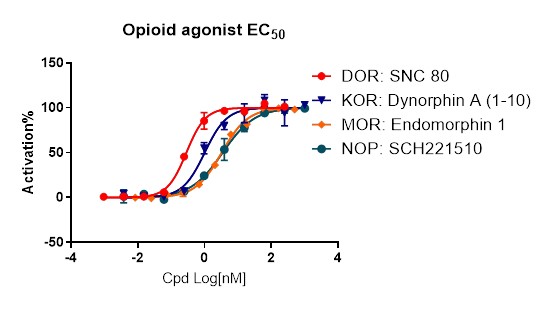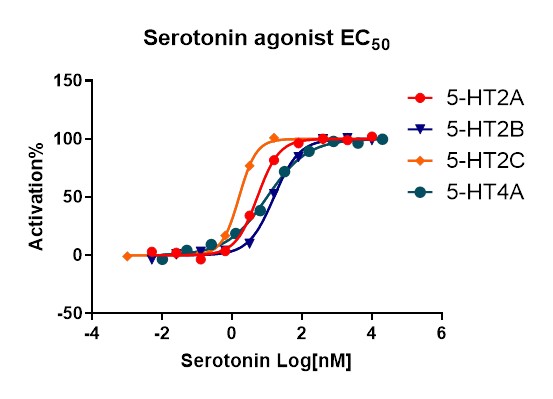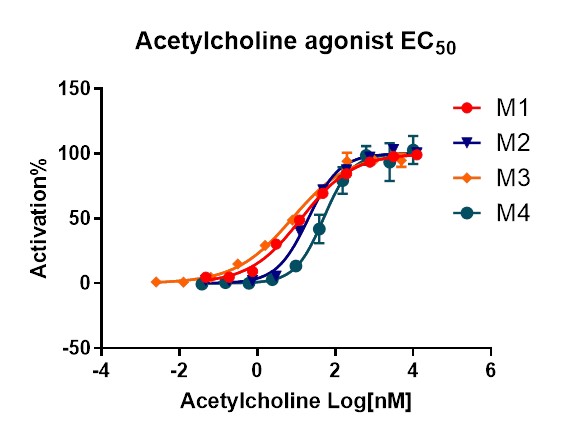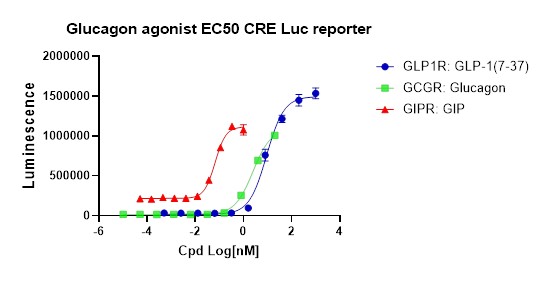GPCRs (G protein-coupled receptors) constitute a crucial class of membrane receptors, surpassing 800 members. These receptors, characterized by seven transmembrane domains, orchestrate various physiological processes through intricate signaling pathways. Their pivotal role has positioned GPCRs as attractive therapeutic targets for a multitude of diseases. Notably, GPCR targets are implicated in 34% of marketed drugs addressing common ailments. Within the realm of FDA-approved drugs, GPCR-targeted medications command over 27% of the global market share.
ICE Bioscience has diligently developed a comprehensive range of solutions for efficient GPCR-based drug discovery and development. Presently, we provide ready-to-use assays covering more than 150 GPCR targets, continually expanding to align with emerging research needs. Complemented by a spectrum of assays and platforms, researchers can explore the multifaceted mechanisms of action associated with GPCRs.
When evaluating the efficacy of GPCR candidates, it is crucial to validate their activity on target receptors through early-stage in vitro testing. The activity of candidates targeting GPCRs can manifest in various ways, including activation, inhibition, allosteric modulation, and more. GPCRs, when activated, initiate signal transduction through cascading signaling responses, forming a complex signaling network. Assessing compound effects on GPCRs can be achieved by monitoring second messengers, phosphorylation levels, and arrestin mechanisms.
✅ A comprehensive collection of ready-to-use GPCR assays featuring over 150 targets across seven species.
✅ Various assay formats available: calcium flux, cAMP, IP3/IP1, β-arrestin, reporter, pERK/pAKT.
✅ High-throughput screening on platforms like ECHO, FLIPR, PHERAstar FSX, LICOR.
✅ Assessment of agonist, antagonist, and PAM functional modes.
✅ Custom cell line develpment services, providing flexibility in cell line choices.
✅ Options for single-concentration screening or dose-response for EC50 and IC50 determination.
✅ Rapid screening with turnaround time of 1-2 weeks.
ICE Bioscience can provide a rapid assessment of drug efficacy, potency, selectivity, and safety, reducing downstream attrition rates in drug development. Benefiting from a comprehensive GPCR target platform, ICE Bioscience offers a versatile spectrum of panel screening solutions for the GPCR family. This includes specialized GPCR panels, safety panels, along with customizable panel testing services. These panels are comprehensively supported by high-throughput instruments, enabling fast and efficient screening and analysis.
GPCR Functional Cell-based Assays Featuring Multiple Readouts
The cell-based functional HTRF cAMP assay is a method used in pharmacological research to measure the intracellular levels of cyclic adenosine monophosphate (cAMP) in response to cellular stimulation. HTRF (Homogeneous Time-Resolved Fluorescence) technology is employed to detect and quantify cAMP levels, providing a reliable and sensitive approach for studying cellular signaling pathways, particularly those involving GPCRs. We provide cell-based functional HTRF cAMP assay using CHO or HEK cells transfected with human opioid receptors.

Evaluation of the potency (EC50) and efficacy (Max response) of compounds for human opioid receptors in transfected CHO or HEK cells determined in a GPCR cell based cAMP assay. The results are expressed as a percent efficacy relative to the maximum response of the control ligands.
The HTRF IP1 (inositol phosphate one) assay is a cell-based functional assay used in pharmacological research to measure the levels of IP1, an inositol phosphate second messenger, in response to cellular stimulation. IP1 is produced as part of the inositol phosphate signaling pathway, which is often activated by GPCR. The assay employs Homogeneous Time-Resolved Fluorescence (HTRF) technology for the detection and quantification of IP1, providing a reliable and sensitive method for studying cellular signaling events. We provide cell-based functional HTRF IP one assay using CHO or HEK cells transfected with human serotonin family receptors.

Evaluation of the potency (EC50) and efficacy (Max response) of compounds for human serotonin family receptors in transfected CHO or HEK cells determined in a GPCR cell based IP1 assay. The results are expressed as a percent efficacy relative to the maximum response of the control ligand.
The FLIPR Calcium Flux Assay is a cell-based functional assay widely used in pharmacological research to measure changes in intracellular calcium levels in response to cellular stimulation. Calcium flux is a crucial signaling event involved in various physiological processes, and this assay is particularly valuable for studying GPCR and other cell surface receptors. We provide FLIPR Calcium Flux Assay using CHO cells transfected with human acetylcholine family receptors.

Evaluation of the potency (EC50) and efficacy (Max response) of compounds for human opioid family receptors in transfected CHO cells determined in a GPCR FLIPR Calcium Flux assay. The results are expressed as a percent efficacy relative to the maximum response of the control ligand.
The β-arrestin NanoBiT Assay is a sophisticated and sensitive method used in pharmacological research to assess the recruitment of β-arrestin to GPCR upon ligand activation. This assay provides valuable insights into the functional activity of GPCRs, specifically their downstream signaling pathways involving β-arrestin. We provide β-arrestin NanoBiT assay using CHO or HEK cells transfected with human opioid family receptors.

Evaluation of the potency (EC50) and efficacy (Max response) of compounds for human opioid family receptors in transfected CHO or HEK cells determined in a GPCR β-arrestin NanoBiT Assay. The results are expressed as a percent efficacy relative to the maximum response of the control ligands.
The CRE-Luc Reporter Assay is a widely used experimental technique in molecular and cellular biology to assess the activity of the cAMP response element (CRE) in response to various stimuli, particularly in the context of GPCR signaling pathways. This assay provides insights into the modulation of gene expression mediated by the CREB (cAMP response element-binding protein) transcription factor. We provide CRE-Luc Reporter Assay using HEK cells transfected with human glucagon family receptors.

Evaluation of the potency (EC50) and efficacy (Max response) of compounds for human glucagon family receptors in transfected HEK cells determined in a GPCR CRE-Luc Reporter Assay. The results are expressed as a percent efficacy relative to the maximum response of the control ligands.